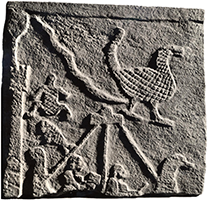Ship with a flat hull and high vertical symmetrical posts with flat topped extremities. The left post is slightly higher. On the left side of the boat is a figure standing on top of a castle, as indicated by his feet resting on the same level as the gunwale. He operates a large curved steering oar supported on a stanchion. Two additional figures are seated inside the boat facing each other, with only their oversized head protruding above the gunwale. Under the boat swim three fish. The depiction is almost certainly that of a riverine craft.
Riverine boat
L25
First half of the 9th century B.C. (?)
Kapara Palace, Tell Halaf
H: 64 cm; W: 42 cm; Th: 18 cm
Small reddish brown sandstone orthostat (stone 35L) with left top corner broken off
Basch 1987: 319-20, no. 674; Cholidis 2014: 93-103 (site); Oppenheim 1931: 169, pl. 29b
Tell Halaf lies in northeastern Syria at the headwaters of the Khabur River. It was founded as the capital of the princes of Pale/Bit-Bahiani which named it Guzana. It's strategic advantage lies in its ready access to one of the main east-west trading routes connecting the Levant to the core of Assyria, as well as the navigable Djirjib River which in addition provided a natural defence due to its steeply sloping bank on the northern flank of the tell. The Western Palace has been identified as the palace of Kapara thanks to an inscription. It is dated to the 10th to 9th century B.C. and was erected atop a high mud brick platform and decorated with rich sculptural ornaments. Its ground plan is that of a bit hilani, a widespread building form in North Syria and southeastern Anatolia. The back side of the bit hilani platform facing the city was originally ornamented along the bottom with about 250 small relief slabs of basalt and red-dyed limestone. The motifs include lions, bulls, cervids, birds, smaller mammals, everyday scenes and mythological themes. The dating of the relief slabs, their possible previous use, and their arrangement are all subject of debate.
Basch, L. 1987. Le musée imaginaire de la marine antique. Athens: Institut Hellénique pour la preservation de la tradition nautique.
Cholidis, N. 2014. “Syro-Hittite States: the Site of Tell Halaf (ancient Guzana),” in J. Aruz, S.B. Graff and Y. Rakic (eds.) Assyria to Iberia at the Dawn of the Classical Age. New York: The Metropolitan Museum of Art, pp. 93-103.
Oppenheim, von M. F. 1931. Der Tell Halaf : eine neue Kultur im ältesten Mesopotamien. Leipzig: F.A. Brockhaus.





